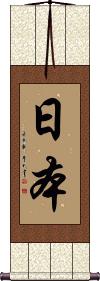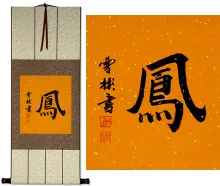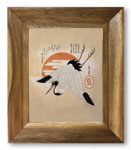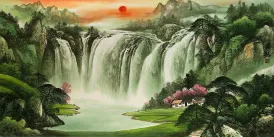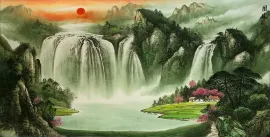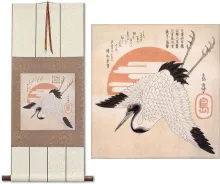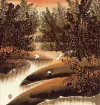Many custom options...
And formats...

Rising Sun in Chinese / Japanese...
Buy a Rising Sun calligraphy wall scroll here!
Personalize your custom “Rising Sun” project by clicking the button next to your favorite “Rising Sun” title below...
Japan
Sunrise
日出 is a Chinese, old Korean Hanja, and Japanese Kanji word that means sunrise.
It literally means “sun coming” or “sun arrival.”
This in-stock artwork might be what you are looking for, and ships right away...
Gallery Price: $130.00
Your Price: $84.88
Gallery Price: $61.00
Your Price: $33.88
Gallery Price: $61.00
Your Price: $33.88
Gallery Price: $61.00
Your Price: $33.88
Gallery Price: $96.00
Your Price: $52.88
Gallery Price: $72.00
Your Price: $39.88
Gallery Price: $120.00
Your Price: $79.88
Not the results for rising sun that you were looking for?
Below are some entries from our dictionary that may match your rising sun search...
| Characters If shown, 2nd row is Simp. Chinese |
Pronunciation Romanization |
Simple Dictionary Definition |
旭日 see styles |
xù rì xu4 ri4 hsü jih kyokujitsu きょくじつ |
the rising sun rising sun; (g,p) Asahi |
先照高山 see styles |
xiān zhào gāo shān xian1 zhao4 gao1 shan1 hsien chao kao shan senshō kōzan |
The rising sun first shines on the highest mountains. |
胎藏界 see styles |
tāi zàng jiè tai1 zang4 jie4 t`ai tsang chieh tai tsang chieh taizō kai |
Garbhadhātu, or Garbhakośa-(dhātu), the womb treasury, the universal source from which all things are produced; the matrix; the embryo; likened to a womb in which all of a child is conceived— its body, mind, etc. It is container and content; it covers and nourishes; and is the source of all supply. It represents the 理性 fundamental nature, both material elements and pure bodhi, or wisdom in essence or purity; 理 being the garbhadhātu as fundamental wisdom, and 智 acquired wisdom or knowledge, the vajradhātu. It also represents the human heart in its innocence or pristine purity, which is considered as the source of all Buddha-pity and moral knowledge. And it indicates that from the central being in the maṇḍala, viz. the Sun as symbol of Vairocana, there issue all the other manifestations of wisdom and power, Buddhas, bodhisattvas, demons, etc. It is 本覺 original intellect, or the static intellectuality, in contrast with 始覺 intellection, the initial or dynamic intellectuality represented in the vajradhātu; hence it is the 因 cause and vajradhātu the 果 effect; though as both are a unity, the reverse may be the rule, the effect being also the cause; it is also likened to 利他 enriching others, as vajradhātu is to 自利 enriching self. Kōbō Daishi, founder of the Yoga or Shingon 眞言 School in Japan, adopted the representation of the ideas in maṇḍalas, or diagrams, as the best way of revealing the mystic doctrine to the ignorant. The garbhadhātu is the womb or treasury of all things, the universe; the 理 fundamental principle, the source; its symbols are a triangle on its base, and an open lotus as representing the sun and Vairocana. In Japan this maṇḍala is placed on the east, typifying the rising sun as source, or 理. The vajradhātu is placed west and represents 智 wisdom or knowledge as derived from 理 the underlying principle, but the two are essential one to the other, neither existing apart. The material and spiritual; wisdom-source and intelligence; essence and substance; and similar complementary ideas are thus portrayed; the garbhadhātu may be generally considered as the static and the vajradhātu as the dynamic categories, which are nevertheless a unity. The garbhadhātu is divided into 三部 three sections representing samādhi or quiescence, wisdom-store, and pity-store, or thought, knowledge, pity; one is called the Buddha-section, the others the Vajra and Lotus sections respectively; the three also typify vimokṣa, prajñā, and dharmakāya, or freedom, understanding, and spirituality. There are three heads of these sections, i. e. Vairocana, Vajrapāṇi, and Avalokiteśvara; each has a mother or source, e. g. Vairocana from Buddha's-eye; and each has a 明王 or emanation of protection against evil; also a śakti or female energy; a germ-letter, etc. The diagram of five Buddhas contains also four bodhisattvas, making nine in all, and there are altogether thirteen 大院 or great courts of various types of ideas, of varying numbers, generally spoken of as 414. Cf. 金剛界; 大日; 兩部. |
旭 see styles |
xù xu4 hsü asahi あさひ |
More info & calligraphy: Morning SunMcIntosh (apple); McIntosh red; (given name) Noboru |
暘 旸 see styles |
yáng yang2 yang hinode ひので |
rising sun; sunshine (surname) Hinode |
初升 see styles |
chū shēng chu1 sheng1 ch`u sheng chu sheng |
rising (sun, moon etc) |
旭光 see styles |
kyokkou / kyokko きょっこう |
rays of the rising sun; (personal name) Akimitsu |
旭旗 see styles |
kyokki きょっき |
rising sun flag |
旭暉 see styles |
kyokki きょっき |
rays of the rising sun |
ご来光 see styles |
goraikou / goraiko ごらいこう |
sunrise viewed from the top of a high mountain; the rising sun |
御来光 see styles |
goraikou / goraiko ごらいこう |
sunrise viewed from the top of a high mountain; the rising sun |
日出国 see styles |
nisshutsukoku にっしゅつこく |
(See 日出ずる国) Land of the Rising Sun; (given name) Hidekuni |
旭日旗 see styles |
kyokujitsuki きょくじつき |
Rising Sun flag; naval ensign of Japan |
旭日章 see styles |
kyokujitsushou / kyokujitsusho きょくじつしょう |
Orders of the Rising Sun |
十二火天 see styles |
shí èr huǒ tiān shi2 er4 huo3 tian1 shih erh huo t`ien shih erh huo tien jūnikaten |
The homa-, or fire-spirits; Whose representations, colours, magic words, signs, symbols, and mode of worship are given in the 大日經疏20. Also 十二火尊; 十二種火法. The twelve fire-spirits are: (1) Indra or Vairocana, the discoverer or source of fire, symbolizing 智 knowledge; (2) the moon 行滿 which progresses to fullness, with mercy as root and enlightenment as fruit, i,e. Buddha; (3) the wind, represented as a half-moon, fanner of fame, of zeal, and by driving away dark clouds, of enlightenment; (4) the red rays of the rising sun, rohitaka, his swords (or rays) indicating 議 wisdom; (5) 沒M004101拏 a form half stern, half smiling, sternly driving away the passions and trials; (6) 忿怒 irate, bellowing with open mouth, showing four teeth, flowing locks, one eye closed; (7) 闍吒羅 fire burning within, i.e. the inner witness, or realization; (8) 迄灑耶 the waster, or destroyer of waste and injurious products within, i.e. inner purification; (9) 意生 the producer at will, capable of all variety, resembling Viśvakarman, the Brahmanic Vulcan; (10) 羯羅微 the fire-eater; (11) untraceable; (12) 謨賀那 the completer, also the subduer of demons. |
旭日昇天 see styles |
kyokujitsushouten / kyokujitsushoten きょくじつしょうてん |
(adj-no,n) (yoji) full of vigor and vitality (like the rising sun); in the ascendant |
日出ずる国 see styles |
hiizurukuni / hizurukuni ひいずるくに |
Land of the Rising Sun |
日出づる国 see styles |
hiizurukuni / hizurukuni ひいづるくに |
Land of the Rising Sun |
旭日中綬章 see styles |
kyokujitsuchuujushou / kyokujitsuchujusho きょくじつちゅうじゅしょう |
Order of the Rising Sun, Gold Rays with Neck Ribbon |
旭日大綬章 see styles |
kyokujitsudaijushou / kyokujitsudaijusho きょくじつだいじゅしょう |
Grand Cordon of the Order of the Rising Sun |
旭日重光章 see styles |
kyokujitsujuukoushou / kyokujitsujukosho きょくじつじゅうこうしょう |
Order of the Rising Sun, Gold and Silver Star; (personal name) Kyokujitsujuukoushou |
ライジングサン see styles |
raijingusan ライジングサン |
(place-name) Rising Sun |
Variations: |
goraikou / goraiko ごらいこう |
sunrise viewed from the top of a high mountain; the rising sun |
Variations: |
hiizurukuni(日出zuru国, 日出国); hiizurukuni(日出zuru国, 日出国) / hizurukuni(日出zuru国, 日出国); hizurukuni(日出zuru国, 日出国) ひいずるくに(日出ずる国, 日出国); ひいづるくに(日出づる国, 日出国) |
Land of the Rising Sun |
和 see styles |
huò huo4 huo wataru わたる |
More info & calligraphy: Peace / Harmony(1) (mathematics term) sum; (2) harmony; peace; (n,n-pref,adj-no) (3) Japan; Japanese-style; (noun or adjectival noun) (kana only) soft; fragile; weak; poorly built; insubstantial; (adj-nari) (archaism) tranquil; calm; quiet; peaceful; calm (at sea); lull; (given name) Wataru Harmony, peace; to blend, mix; with, unite with; respond, rhyme. |
国 see styles |
kokuki こくき |
More info & calligraphy: Guo |
國 国 see styles |
guó guo2 kuo kuniyuki くにゆき |
More info & calligraphy: Guo(out-dated kanji) (1) country; state; (2) region; (3) national government; central government; (4) home (i.e. hometown, home country); (5) (archaism) province (of Japan); (6) (archaism) land; earth; (personal name) Kuniyuki A country, a nation; national. |
強 强 see styles |
qiǎng qiang3 ch`iang chiang kyou / kyo きょう |
More info & calligraphy: Strong / Powerful / Force(suffix) (1) (ant: 弱・1) a little over; a little more than; (2) (ant: 弱・2) strength; the strong; (suffix) (3) powerhouse; one of the biggest; one of the most powerful; (suffix) (4) (after a number on the Japan Meteorological Agency seismic intensity scale; e.g. 5強) (ant: 弱・3) -upper (seismic intensity); (personal name) Tsuyomi Strong, forceful, violent; to force; to strengthen. |
磬 see styles |
qìng qing4 ch`ing ching kei / ke けい |
More info & calligraphy: Khánhsounding stone; qing; ancient Chinese chime shaped like a chevron (inverted 'v'), orig. of stone, today often metal, in Japan primarily used at Buddhist temples; (given name) Kei A piece of flat stone or metal, used as a gong, or for musical percussion. |
道 see styles |
dào dao4 tao dou / do どう |
More info & calligraphy: Daoism / Taoism(1) (abbreviation) (See 道・みち・1) road; path; street; route; (2) (See 道・みち・5) way; set of practices; rules for conducting oneself; (3) (abbreviation) (in Japanese schools) (See 道徳教育) moral education; (4) Buddhist teachings; (5) Taoism; (6) administrative region of Japan (Hokkaido); (7) (hist) administrative region of Japan (Tokaido, Tosando, etc.); (8) province (administrative region of Korea); (9) circuit (administrative region of China); (10) (hist) province (Tang-era administrative region of China); (personal name) Wataru mārga. A way, road; the right path; principle, Truth, Reason, Logos, Cosmic energy; to lead; to say. The way of transmigration by which one arrives at a good or bad existence; any of the six gati, or paths of destiny. The way of bodhi, or enlightenment leading to nirvāṇa through spiritual stages. Essential nirvāṇa, in which absolute freedom reigns. For the eightfold noble path v. 八聖道.; The two Ways: (1) (a) 無礙道 or 無間道 The open or unhindered way, or the way of removing all obstacles or intervention, i. e. all delusion; (b) 解脫道 the way of release, by realization of truth. (2) (a) 難行道 The hard way of "works", i. e. by the six pāramitā and the disciplines. (b) 易行道 the easy way salvation, by the invocation of Amitābha. (3) (a) 有漏道 The way of reincarnation or mortality; (b) 無漏 the enlightened way of escape from the miseries of transmigration. (4) (a) 教道 The way of instruction; (b) 證道 the way of realization. (5) The two lower excretory organs. |
Click here for more rising sun results from our dictionary
The following table may be helpful for those studying Chinese or Japanese...
| Title | Characters | Romaji (Romanized Japanese) | Various forms of Romanized Chinese | |
| Japan | 日本 | nippon / nihon nipon / nihon | rì běn / ri4 ben3 / ri ben / riben | jih pen / jihpen |
| Sunrise | 日出 | nisshutsu / nishutsu | rì chū / ri4 chu1 / ri chu / richu | jih ch`u / jihchu / jih chu |
Successful Chinese Character and Japanese Kanji calligraphy searches within the last few hours...
